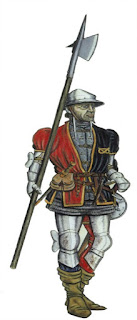Caballero normando (1066)
http://www.warriorsfortheworkingday.com/Normanknight.htm
Uno de los seguidores de Guillermo el Conquistador que acabaron con la Inglaterra sajona tras derrotar al rey Harold y a sus guerreros en un sangriento día de octubre en la colina de Senlac el año 1066. La espina dorsal del ejército normando era el caballero, un guerrero feudal entrenado para la guerra desde la infancia, acostumbrado a luchar desde la silla de montar en grupos de caballeros entrenados, eran las tropas de choque de su época. El caballero está vestido con una cota de malla hasta la rodilla, con un corte hasta la ingle para facilitar la monta, la malla tiene una capucha o cofia usada sobre la cabeza y sobre la misma el caballero usa un casco cónico con un nasal para proteger la cara. En este ejemplo el casco está formado por varias piezas y pintado, pero cascos elaborados a martillazos de una sola pieza de hierro también eran habituales. Su escudo con forma de cometa da una buena protección a la mano que sujeta la brida y al costado izquierdo del cuerpo. Armado con una espada o lanza, que era a veces lanzada como una jabalina los caballeros estaban acostumbrados
One of William the Conqueror’s followers whobrought an end to Saxon England by defeating King Harold and his warriors one bloody October day on Senlac Hill in 1066. The backbone of the Norman army was the mounted knight, a feudal warrior trained in war from childhood, used to fighting from the saddle in trained bodies of knights, they were the shock troops of their era. The knight is dressed in a knee length mail shirt, split to the crotch to facilitate riding, the mail has a hood or coif worn over the head and above that the knight wears a conical helmet with a nasal to protect the face. In this instance the helm is constructed in several pieces and is painted, but helmets hammed from a single piece of iron were also common. His kite shaped shield gives good protection to the bridle hand and left side of the body. Armed with sword or spear, which was sometimes thrown as a javelin the knights were well used to fighting from horseback and the deep Norman saddle gave the mounted warrior a secure seat in combat.The illustration is interpreted from the Bayeux Tapestry which is a superb historical source for these men who changed the shape of English history.
Montjoie Saint Denis '- caballero francés 1370-1400
http://www.warriorsfortheworkingday.com/frenchknight.htm
This illustration shows the typical opponent of the English bowmen in France in the late fourteenth and early fifteenth centuries. This man is bravely facing the feathered death so amply provided by the English bowmen.
The Knight, mounted on his heraldically barded destrier is well armed in contemporary fashion. His helmet is a visored bascinet with a hanging mail aventail. On his body he wears a padded ' jupon ' based on an example dated around 1380 and worn by Charles VI of France which is still preserved in Chartres. Beneath the jupon would be extra defences of mail or plate. He wears full plate defences on his legs and steel gauntlets. he is armed with spear, sword and mace and would bear a dagger hanging from the enamelled belt worn around his hips.
The heraldry shown is conjectural and does not represent any particular family but rather attempts to typify those nobles of
France who tried to stem the English tied and often died trying.
Alabardero en la Guerra de las Dos Rosas
http://www.warriorsfortheworkingday.com/billman.htm
Soldiers such as the figure portrayed here were the hand to hand infantry of the fifteenth century fighting alongside the heavily armoured men at arms. Armed with a variety of pole arms generically known as bills and relatively well armoured for their combat role.
The billman portrayed here wears the livery coat and badge of the Stafford family, Dukes of Buckingham. Beneath this ‘uniform’ coat he wears a mail shirt and brigandine, a descendent of the coat of plates, his limbs are protected by plate armour and he wears gauntlets. His helmet is a broad brimmed ‘kettle hat’ although closer fitting sallet helmets either with or without visor were frequently worn. The soldier’s particular pole arm is a halberd with axe blade, hook and spike and he also carries a sword, dagger and an iron buckler shield. Blocks of billmen were a major feature on both sides in the internecine struggle of the Wars of the Roses



No hay comentarios:
Publicar un comentario